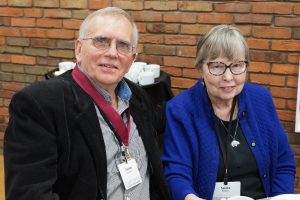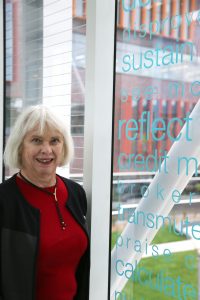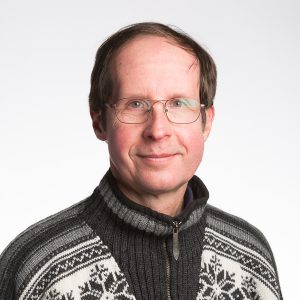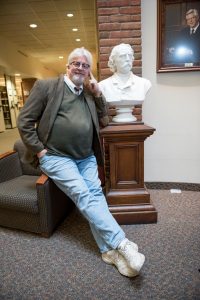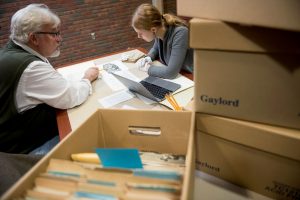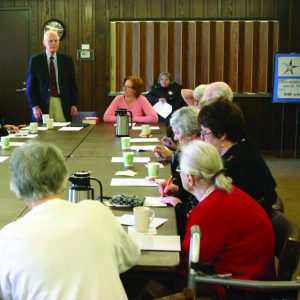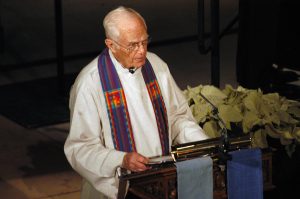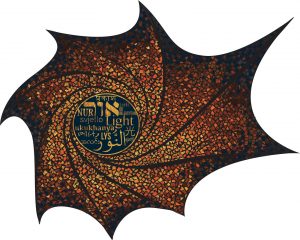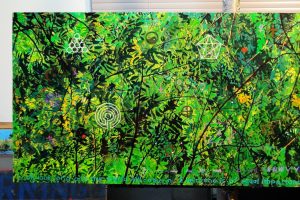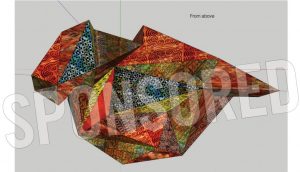Kristine (Michaelsen) Wickens ’73 says Trinity Lutheran Congregation and Augsburg University have been inseparable for a long time. She should know: Her family tree includes two Augsburg presidents, great grandfather Georg Sverdrup (1876-1907) and his son, George Sverdrup (1911-1937), and five generations of Trinity members and leaders. In 1993, Trinity celebrated its 125th anniversary by creating the Trinity Lutheran Scholarship at Augsburg. The endowed scholarship also remembers life-long Trinity member George Sverdrup Michaelsen ’31, Kristine’s father. Michaelsen, a professor of public health at the University of Minnesota, was president of Trinity, chairman of the board of Lutheran Deaconess Hospital, and chair of the Augsburg Board of Regents. The scholarship fund was later augmented with an estate gift from Michaelsen’s sisters, Katherine and Else Michaelsen ’31.
Serving immigrants since 1868
The Trinity–Augsburg connection goes back to 1868, when Norwegian and Danish immigrants formed Trinity Lutheran. The congregation soon built a small wooden church at the corner of 12th Avenue and 3rd Street South, where US Bank Stadium now stands. Trinity leaders encouraged Augsburg Seminary to move from Wisconsin to the Cedar-Riverside neighborhood in 1872, and their collaboration led to the creation of Lutheran Deaconess Hospital in 1888. The trio of institutions became indispensible to the immigrant community, and by the 1890s Trinity had over 1,200 members. In 1897, Trinity earned the nickname, “The Mother of the Free Church,” when Trinity, Augsburg and a handful of other congregations formed the Lutheran Free Church, a group of independent congregations committed to congregational autonomy and personal Christianity.
“Homeless congregation” finds a place at Augsburg
In 1966, Trinity’s 1000-seat building on 20th Avenue was demolished to make way for I-94 construction. “Rather than disbanding, the congregation accepted offers from Riverside Presbyterian Church and then Our Lady of Perpetual Help Catholic Church for worship and office space,” explains Wickens. “There was a tremendous commitment to Cedar-Riverside, just as Augsburg has always been committed to its inner-city location and community.” Augsburg began providing Trinity with worship space in the 1990s. The two institutions and other partners host community suppers at Trinity’s common space, and Augsburg students volunteer at Trinity’s drop-in tutoring program for K-12 students from the neighborhood, many of whom are Muslim immigrants.
Campus Connections
The lives of the Sverdrup and Michaelsen families have been intertwined with Augsburg and Trinity for five generations. “The campus was so familiar to me,” remembers Kristine, who grew up six blocks from campus. “Everything we did had some kind of Augsburg or Trinity connection.” She remembers visiting her grandmother, Else Sverdrup Michaelsen (Georg’s daughter) who, after the death of her husband Michael Michaelsen ’xx continued to live on campus until her own death in 1965. Today, Kristine and two of her siblings, Jennifer (Michaelsen) Windingstad ’67 and George Michaelsen II, remain members of Trinity. Another sister, Mary (Michaelsen) Garmer ’69 and her husband Reverend Gregory Garmer ’68 live in Duluth. Peter Windingstad studied at Augsburg before transferring to the University of Wisconsin. Many members of the family are donors to Augsburg.
Looking back on the two institutions’ shared history, Kristine sees theirs as a story of immigration; from the Scandinavians of the 19th century to the East African and other immigrants living in the Cedar-Riverside area today, and all those in between. “My family were immigrants,” she says. “It’s essential that we welcome new people, include them in our lives and help them get established.”

